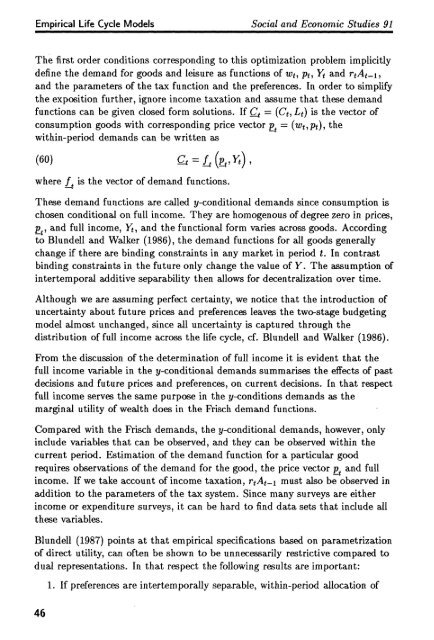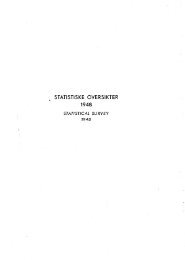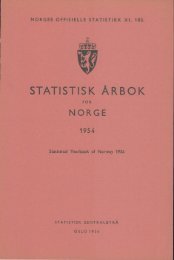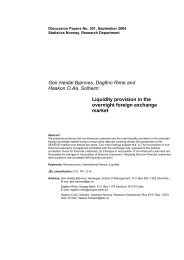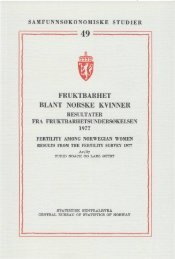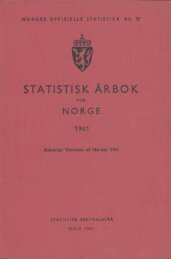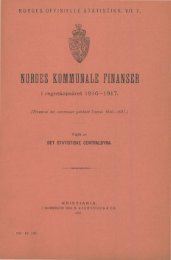Empirical life cycle models of labour supply and - Statistisk sentralbyrå
Empirical life cycle models of labour supply and - Statistisk sentralbyrå
Empirical life cycle models of labour supply and - Statistisk sentralbyrå
You also want an ePaper? Increase the reach of your titles
YUMPU automatically turns print PDFs into web optimized ePapers that Google loves.
<strong>Empirical</strong> Life Cycle Models Social <strong>and</strong> Economic Studies 91<br />
The first order conditions corresponding to this optimization problem implicitly<br />
define the dem<strong>and</strong> for goods <strong>and</strong> leisure as functions <strong>of</strong> wt, Pt, Yt <strong>and</strong> rtAt-i,<br />
<strong>and</strong> the parameters <strong>of</strong> the tax function <strong>and</strong> the preferences. In order to simplify<br />
the exposition further, ignore income taxation <strong>and</strong> assume that these dem<strong>and</strong><br />
functions can be given closed form solutions. If _C_t f (Ce , Lt) is the vector <strong>of</strong><br />
consumption goods with corresponding price vector pt = (tvt , Pt), the<br />
within-period dem<strong>and</strong>s can be written as<br />
(60) = (Pt , Yt)<br />
where Lt is the vector <strong>of</strong> dem<strong>and</strong> functions.<br />
These dem<strong>and</strong> functions are called y-conditional dem<strong>and</strong>s since consumption is<br />
chosen conditional on full income. They are homogenous <strong>of</strong> degree zero in prices,<br />
pt , <strong>and</strong> full income, Y, <strong>and</strong> the functional form varies across goods. According<br />
-to Blundell <strong>and</strong> Walker (1986), the dem<strong>and</strong> functions for all goods generally<br />
change if there are binding constraints in any market in period t. In contrast<br />
binding constraints in the future only change the value <strong>of</strong> Y. The assumption <strong>of</strong><br />
intertemporal additive separability then allows for decentralization over time.<br />
Although we are assuming perfect certainty, we notice that the introduction <strong>of</strong><br />
uncertainty about future prices <strong>and</strong> preferences leaves the two-stage budgeting<br />
model almost unchanged, since all uncertainty is captured through the<br />
distribution <strong>of</strong> full income across the <strong>life</strong> <strong>cycle</strong>, cf. Blundell <strong>and</strong> Walker (1986).<br />
From the discussion <strong>of</strong> the determination <strong>of</strong> full income it is evident that the<br />
full income variable in the y-conditional dem<strong>and</strong>s summarises the effects <strong>of</strong> past<br />
decisions <strong>and</strong> future prices <strong>and</strong> preferences, on current decisions. In that respect<br />
full income serves the same purpose in the y-conditions dem<strong>and</strong>s as the<br />
marginal utility <strong>of</strong> wealth does in the Frisch dem<strong>and</strong> functions.<br />
Compared with the Frisch dem<strong>and</strong>s, the y-conditional dem<strong>and</strong>s, however, only<br />
include variables that can be observed, <strong>and</strong> they can be observed within the<br />
current period. Estimation <strong>of</strong> the dem<strong>and</strong> function for a particular good<br />
requires observations <strong>of</strong> the dem<strong>and</strong> for the good, the price vector pt <strong>and</strong> full<br />
income. If we take account <strong>of</strong> income taxation, rtAt_i must also be observed in<br />
addition to the parameters <strong>of</strong> the tax system. Since many surveys are either<br />
income or expenditure surveys, it can be hard to find data sets that include all<br />
these variables.<br />
Blundell (1987) points at that empirical specifications based on parametrization<br />
<strong>of</strong> direct utility, can <strong>of</strong>ten be shown to be unnecessarily restrictive compared to<br />
dual representations. In that respect the following results are important:<br />
46<br />
1. If preferences are intertemporally separable, within-period allocation <strong>of</strong>


